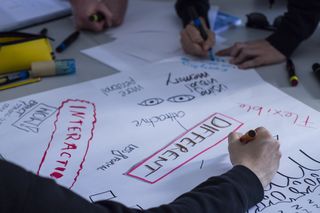Leadership
How to Model Care and Creativity as a Leader
Don't Let Their Concerns and Ideas Go Unheard
Posted April 13, 2020
While speed and efficiency are necessary leadership traits in our always-on, do-more, #Covid19 world, there’s also a point of diminishing returns. If we let agendas and clocks dictate all of our meetings, we could undermine our own efforts to connect with our team members and discourage meaningful collaboration and innovative thinking.
Consider the unfortunate impact.
Many people are reluctant to speak up and contribute something that disrupts the cadence of a meeting. They feel compelled to stay on task. And, they don’t want to be “that person” who goes off on a tangent and takes the whole team down the rabbit hole.
The result? Concerns and great ideas go unheard. Conversations that could lead to more bonded teams and breakout concepts are stifled and thwarted. And brainstorming gets truncated by the buzz from an Apple Watch signaling “time’s up!”
As a leader, you can selectively emphasize care and creativity over efficiency to get the most out of your team. The next time you plan a meeting, limit the topics on the agenda so you’re not compelled to race through every item. Start with an open forum so that you can check-in and listen to the concerns that may be keeping people from being fully present. Use the opportunity to be transparent by sharing what adjusting has meant for you. And finally, model what it looks like to be enterprising under unprecedented circumstances by tossing out some new workflow ideas and inviting your team to do the same.
Some of you might initially have mixed reactions to that approach. You can see how it would enable the space for greater collaboration. However, it also might seem unrealistic, given the amount of information that needs to be shared and the sense of urgency related to our current circumstances. Here’s a viable solution for that.
Share information prior to the meeting, and reserve your time together for discussion and brainstorming. To do that, collect concise updates from each of your team members, and distribute those and your updates in advance for everyone to review. Ask team members to prepare by reading through all the briefs, jotting down any pertinent questions, and developing some ideas. Once people arrive for the meeting, everyone is already up to date and ready to contribute at an optimal level. That shifts the emphasis from disseminating information to collaborating and discussing.
No doubt about it, efficiency is still critical. But, sometimes, discovery and dialogue need to take the lead as an investment for long-term success. When you provide the space for conversations to flow and ideas to percolate, you’ll give your team the best possible chance to bond and develop some game-changing ideas.



